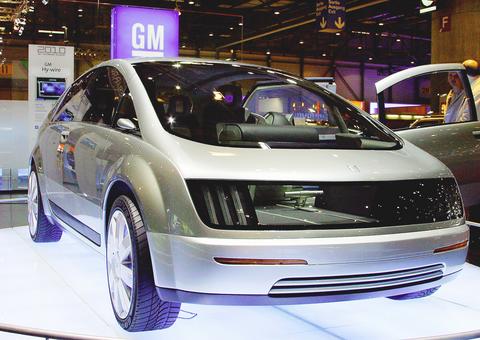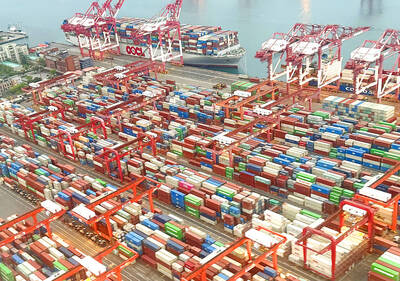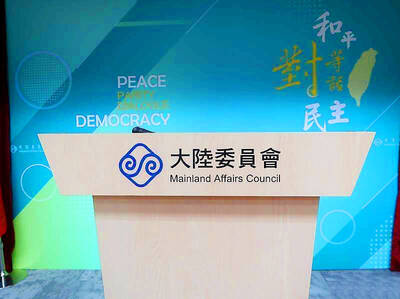Drivers of some General Motors minivans will soon be pulling into a Shell station here to fill up on hydrogen, the two companies announced Tuesday. They said it would be the first hydrogen pump at an American service station and that hydrogen cars could be in showrooms by the end of the decade.
But skeptics wonder if these supposed cars of the future will be powered mainly by an old-fashioned indigenous source of energy: politics. Critics say these experimental cars will be cruising Washington mainly to impress Congress so that the auto industry gets more subsidies and feels less pressure to improve the fuel efficiency of current cars.
Hydrogen-powered cars became Washington's hot wheels during the State of the Union speech in January, when President Bush proposed more research and predicted that the cars could be commercially practical by 2020.

PHOTO: NY TIMES
The cars, which emit only water vapor from their tailpipes, could help reduce pollution and oil consumption, but some experts wonder if they will ever be affordable.
The six experimental minivans that are scheduled to arrive in Washington in May have cost more than US$1 million apiece, said Dr. Larry Burns, GM's vice president for research and development and planning. Each minivan, an Opel Zafira converted to house a stack of fuel cells that generate electricity through a chemical reaction that uses hydrogen, has enough power to accelerate crisply and reach 100 miles per hour, he said.
"We think we can build a compelling and affordable car by 2010," he said. "It's a big challenge, but as a technologist, you have to be optimistic. Four years ago, I never dreamed we'd have made as much progress as we have by now. So far, we haven't seen anything that says it can't be done."
Back in Washington's court
The experimental cars will not end up in any home garages, at least not soon. They will be lent for test drives, and the managers of the program expect many of the test drives to start from Capitol Hill.
"There's a real important reason for our policy-makers to have exposure to this technology," Burns said.
Experimental fleets of hydrogen cars built by Toyota and Honda have been operating in California since last year, and GM expects to put hydrogen-powered Federal Express trucks on the streets of Tokyo next week. The chief innovation in Washington is the cooperation between a car maker and an oil company. One obstacle to the spread of hydrogen cars is the chicken-and-egg problem of building cars for which there are no refueling stations.
"Shell's work with GM will show that filling up the car with hydrogen is as simple and safe as filling up with gasoline," said Donald Huberts, the chief executive of Shell Hydrogen. He said that a local Shell station would be reconfigured by October to dispense hydrogen during the rest of the experiment, which is to last until 2005.
The hydrogen dispensers are supposed to have the look and feel of regular gasoline pumps. Drivers will use hoses with specially fitted valves to fill their tanks. Some of the cars will use extremely cold liquid hydrogen; others will use hydrogen in a compressed, gaseous form.
The two companies are paying for this project themselves, but their executives said they hoped that the federal government would help pay for similar research in the future and perhaps buy fleets of cars. The Bush administration has announced plans to spend US$1.7 billion over five years on two projects: the FreedomCar, to explore making the technology work in hydrogen cars, and FreedomFuel, which will study how to produce, store and deliver hydrogen.
Although environmentalists like the prospect of clean hydrogen cars, some of them criticized Bush for focusing on a car of the future instead of the ones on the road today. They said he was using the hydrogen car as a way to protect the auto industry from tougher standards for fuel economy and emissions today.
Presidential freedom
"The so-called FreedomCar initiative is really about freedom for the president not to support energy independence today," said Nathanael Greene, a policy analyst with the Natural Resources Defense Council.
Daniel F. Becker, the director of the Sierra Club's global warming and energy program, said the FreedomCar was reminiscent of a Clinton administration program that spent more than US$1 billion on a new generation of fuel-efficient cars but failed to produce any for sale.
"It is a sham program," he said, "merely designed to create the impression that Detroit and the Bush administration are moving toward clean cars when they have no such intention."
The GM hydrogen cars coming to Washington were dismissed as "PR cars" by Jerry Taylor, the director of natural resource studies at the Cato Institute.
He said he was skeptical that bringing them to Washington would yield any public benefit, because politicians here have never shown much of a knack for spotting the next great source of energy.
"The federal government's record in picking winners in the energy industry is so bad that random investments would have almost certainly yielded higher returns," Taylor said.
"Nuclear power, synthetic fuels, solar and wind power, clean coal -- all have been sinkholes for tax dollars, but bonanzas for well-connected industries."?

CARROT AND STICK: While unrelenting in its military threats, China attracted nearly 40,000 Taiwanese to over 400 business events last year Nearly 40,000 Taiwanese last year joined industry events in China, such as conferences and trade fairs, supported by the Chinese government, a study showed yesterday, as Beijing ramps up a charm offensive toward Taipei alongside military pressure. China has long taken a carrot-and-stick approach to Taiwan, threatening it with the prospect of military action while reaching out to those it believes are amenable to Beijing’s point of view. Taiwanese security officials are wary of what they see as Beijing’s influence campaigns to sway public opinion after Taipei and Beijing gradually resumed travel links halted by the COVID-19 pandemic, but the scale of

TRADE: A mandatory declaration of origin for manufactured goods bound for the US is to take effect on May 7 to block China from exploiting Taiwan’s trade channels All products manufactured in Taiwan and exported to the US must include a signed declaration of origin starting on May 7, the Bureau of Foreign Trade announced yesterday. US President Donald Trump on April 2 imposed a 32 percent tariff on imports from Taiwan, but one week later announced a 90-day pause on its implementation. However, a universal 10 percent tariff was immediately applied to most imports from around the world. On April 12, the Trump administration further exempted computers, smartphones and semiconductors from the new tariffs. In response, President William Lai’s (賴清德) administration has introduced a series of countermeasures to support affected

Pope Francis is be laid to rest on Saturday after lying in state for three days in St Peter’s Basilica, where the faithful are expected to flock to pay their respects to history’s first Latin American pontiff. The cardinals met yesterday in the Vatican’s synod hall to chart the next steps before a conclave begins to choose Francis’ successor, as condolences poured in from around the world. According to current norms, the conclave must begin between May 5 and 10. The cardinals set the funeral for Saturday at 10am in St Peter’s Square, to be celebrated by the dean of the College

CROSS-STRAIT: The vast majority of Taiwanese support maintaining the ‘status quo,’ while concern is rising about Beijing’s influence operations More than eight out of 10 Taiwanese reject Beijing’s “one country, two systems” framework for cross-strait relations, according to a survey released by the Mainland Affairs Council (MAC) on Thursday. The MAC’s latest quarterly survey found that 84.4 percent of respondents opposed Beijing’s “one country, two systems” formula for handling cross-strait relations — a figure consistent with past polling. Over the past three years, opposition to the framework has remained high, ranging from a low of 83.6 percent in April 2023 to a peak of 89.6 percent in April last year. In the most recent poll, 82.5 percent also rejected China’s